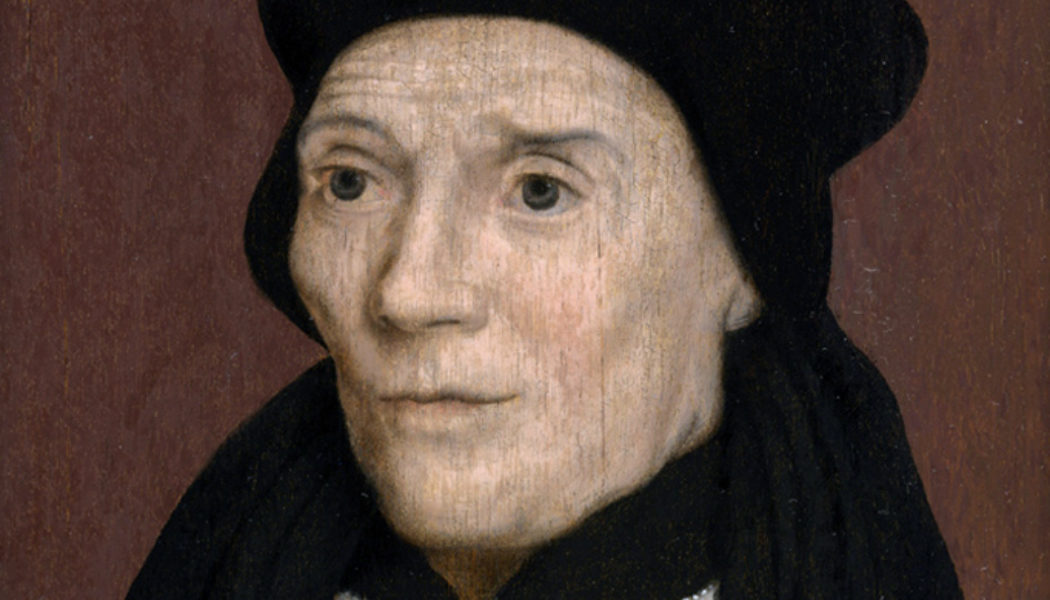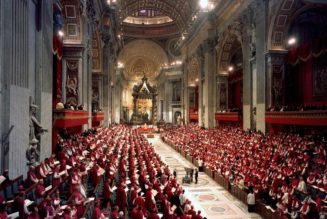
It’s not Thomas More’s fault. His fame is so widespread that he has put in the shade the only English bishop who had the guts to stand up to Henry VIII, and lost his head because of it. That bishop was St. John Fisher (1469-1535).
Certainly, most if not all of the Register’s readers will recognize that name. But let’s face it, what Fisher needs is his own version of A Man for All Seasons — a big, gorgeously filmed, beautifully written, destined-to-be-a-classic film, with an all-English cast. So, until some Hollywood producer gives this concept the green light, here’s a very brief introduction to one of the glories of Catholic English.
John Fisher grew up to be one of the “new men,” a sneering term the English aristocracy used for intelligent, clever, accomplished fellows who came from the lower classes yet rose to high office. It was the unshakable opinion of the English nobility that by right of birth and inheritance, those distinguished positions belonged to them. So, when Fisher, a cloth merchant’s son, was elected chancellor-for-life of Cambridge University, and Henry VIII appointed Thomas More, a lawyer’s son, Chancellor of England — and worst of all, when Thomas Wolsey, a butcher’s son, rose to became cardinal, papal nuncio and Chancellor of England — the nobles were close to apoplectic.
To their credit, Fisher, More, and Wolsey ignored the snubs and the snickers and went about their work.
In John Fisher’s case, people began to notice his intellectual brilliance and his religious devotion when he was just a teenager studying at Cambridge. His spiritual life was so mature that he received a dispensation to be ordained a priest when he was only 22.
He was happiest at the university. Yet, when he was named chancellor of Cambridge he found a school where virtually nothing had changed in centuries, that could use what we would call a few upgrades. At a time when there was an almost feverish interest in the study of Sacred Scripture, no one at Cambridge taught Hebrew or Greek — the original languages of the Old and New Testaments. Then there was the university library — it was an embarrassment, with barely 300 volumes on its shelves. To correct these defects, Fisher found men who were fluent in Greek and Hebrew; he established scholarships for students eager to master these ancient languages; he transformed the anemic library into a serious collection of books; and he invited Erasmus, the Christian humanist rock star of his day, to settle in Cambridge as a long-term visiting professor.
As a full-time university administrator, Fisher was not expected to take on parish duties, but he did assist souls one-on-one. Lady Margaret Beaufort, the mother of Henry VII and grandmother of Henry VIII, asked Fisher to be her confessor and spiritual director. They were a perfect fit — both the priest and the lady were people of deep piety and deep learning. Lady Margaret also had immense wealth, and with Fisher’s encouragement she founded two new colleges at Cambridge, Christ College and St. John’s College, and she endowed two professorships in divinity, one at Cambridge and another at Oxford. It was probably at his mother’s recommendation that Henry VII named Fisher bishop of Rochester.
It was not uncommon at that time for a bishop to collect the income from his diocese, live where he pleased, and send an administrator to run the place for him. Fisher was not that type of bishop. He left his beloved Cambridge and settled into the bishop’s residence in Rochester. To elevate religious life, he visited every parish of his diocese, corrected wayward clergy, and insisted that priests preach well-thought-out, understandable, orthodox sermons. He was zealous in administering Confirmation — a sacrament the absentee bishops neglected. He gave generously to the poor, and visited the sick in their homes. He lived simply — no lavish, multi-course feasts, no opulent furnishings. His one indulgence was his personal library. He was an avid collector of fine books, which he planned to bequeath to Cambridge.
And he kept up his intellectual life. As a bishop, he had a new platform and he used it to write and preach against abuses in the Church. When Martin Luther spread confusion and rebellion among Catholics, Fisher harnessed his gifts to defend the faith.
The Holy Roman Emperor’s ambassador in England declared that Fisher was “the paragon of bishops for learning and holiness.” Henry VIII boasted that no king in Europe had a bishop who could compare with John Fisher.
And then along came Anne Boleyn. Henry’s passion for Anne would bring down Wolsey, take the lives of Fisher, More, and countless others, and destroy the Catholic Church in England. It began with Henry appealing to the pope to annul his marriage to his queen, Katherine, so he could marry Anne. Bishop Fisher examined the case and found nothing to suggest the royal marriage was invalid. He became one of Katherine’s champions, and was active in her defense before Cardinal Lorenzo Campeggio, whom Pope Clement VII had sent to England to resolve the matter. By siding with the queen, Fisher angered Henry. There is a Latin saying that roughly translates, “To anger a king means death.” And Fisher’s life was in danger. Someone poisoned his food—he didn’t eat it, but two members of his household did and they died. And then someone fired a shot through the window of his library: the bullet missed the bishop.
Fisher was operating from the perspective of spiritual authority, legal precedent, and rational thought. Henry had no use for any of these time-tested methods. He wanted what he wanted, and he was going to get it. In 1534, the king forced through Parliament a bill that granted him the title “Supreme Head of the Church in England.” Fisher was the only bishop in the realm to oppose it. Henry’s response was to charge Fisher with treason and imprison him in the Tower of London.
In the Tower, Fisher was treated cruelly. He was locked in a freezing cell with no sheets or blankets for his bed and only the clothes he had on his back when he was arrested. All of his personal property had been confiscated, so even if one of his servant could have gotten into the bishop’s house in Rochester, there was nothing left to take to the Tower. If he had had any money of his own he could have sent for decent food, but since he was penniless, Fisher was one of those wretched unfortunates who had to eat whatever was provided from the prison kitchen.
On several occasions bishops were sent to bully Fisher into declaring Henry’s marriage to Katherine invalid and recognizing the king’s title as Supreme Head of the Church in England as legitimate. One of those bishops came away from his meeting with Fisher deeply shaken by what he had seen. Fisher was in rags, shivering with cold, and so thin the visiting bishop thought the old man half dead. In an additional example of heartlessness, Henry would not permit Fisher to say Mass, nor to hear Mass in either of the Tower’s two chapels—a privilege which was generally granted to prisoners. Furthermore, the bishops who came to dispute with Fisher were forbidden to hear his confession or bring him Holy Communion.
In May 1535, the thirteenth month of Fisher’s imprisonment, Pope Paul III announced that he had created Fisher a cardinal and was sending the elaborate cardinal’s hat to England. When Henry VIII heard the news he swore that by the time the hat arrived Fisher would have no head on which to wear it.
On June 17, Fisher was tried in Westminster Hall, found guilty of treason, and sentenced to be hanged, drawn, and quartered. He was so frail he would have died long before all the barbarities of that sentence could be carried out, and so, reluctantly, Henry modified the sentence to beheading.
On June 22 a guard came to Fisher’s cell to take him to his execution. Even now, he was denied the sacraments. He was too weak to walk, so guards carried the bishop in a chair to Tower Hill. From the scaffold he addressed the crowd, saying he died for the Holy Catholic faith. Then he knelt and prayed the Te Deum, the great hymn of praise, and Psalm 31, “In You, O Lord, have I hoped.” When he had finished, he laid his neck on the block and the executioner cut off his head.
As a final indignity, Henry had ordered Fisher’s body stripped naked and left exposed on the scaffold until evening. Workmen from the Tower collected the corpse and dumped it, naked, without even a shroud, into a shallow trench in the nearby graveyard of the Church of All Hallows. No priest was summoned to say the committal prayers. No family or friends were permitted to attend the burial. Cardinal John Fisher never had a Requiem Mass. As for his head, it was mounted on a spike on Tower Bridge. Two weeks later it was removed and tossed into the Thames River to make room for the head of Thomas More.
When the authorities learned that Londoners were gathering to pray at Fisher’s grave, the body was exhumed and buried inside the Tower, in the crypt of the Chapel of St. Peter ad Vincula (St. Peter in Chains). In 1876, an excavation crew working in the crypt found two skeletons they believed were the bones of St. John Fisher and St. Thomas More. The relics were placed together in a single vault that is marked today with a portrait bust of St. Thomas More. Even at his grave, John Fisher receives no recognition.
This article originally appeared in the Register June 22, 2017.









